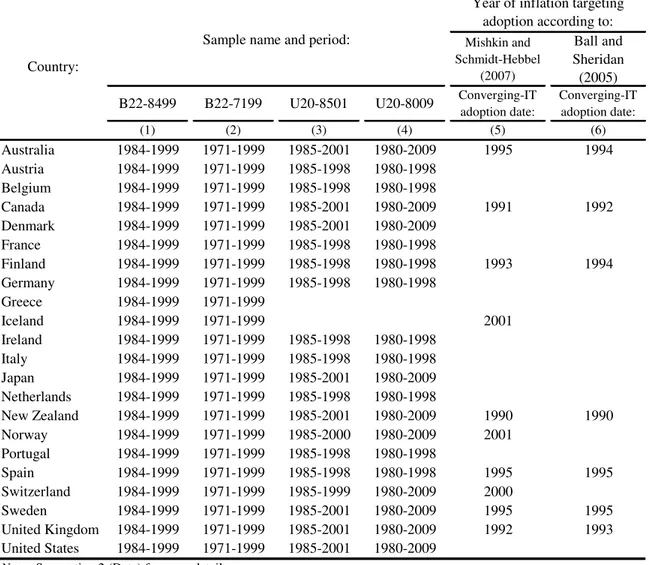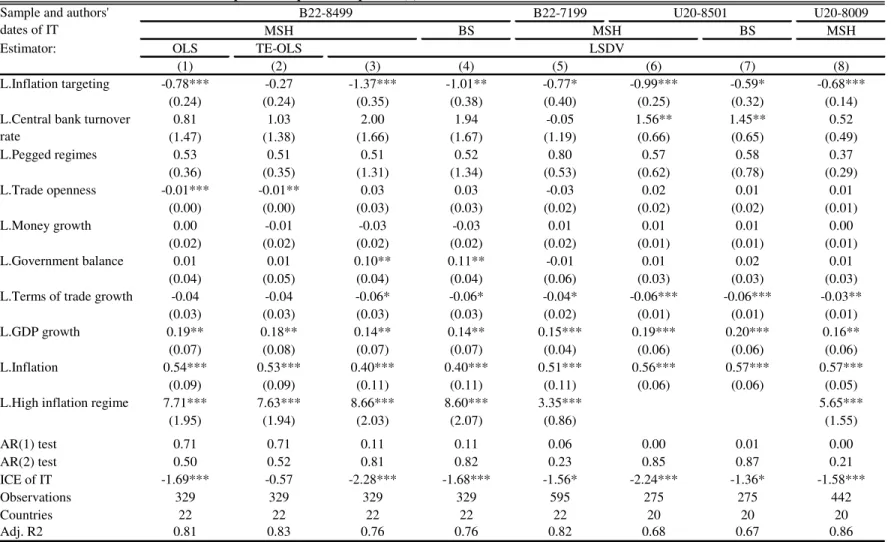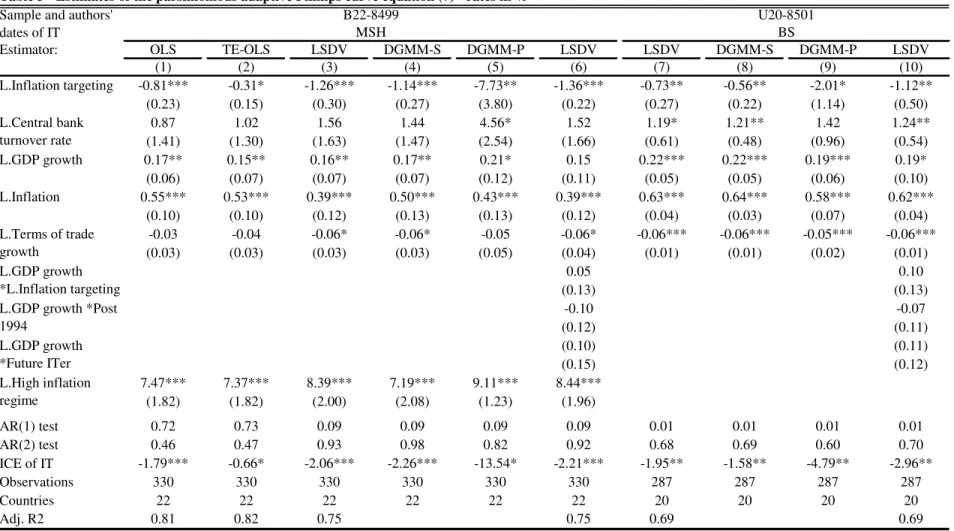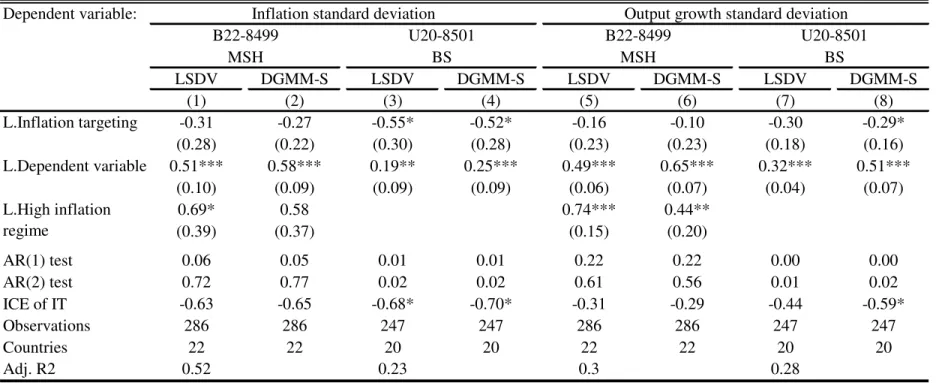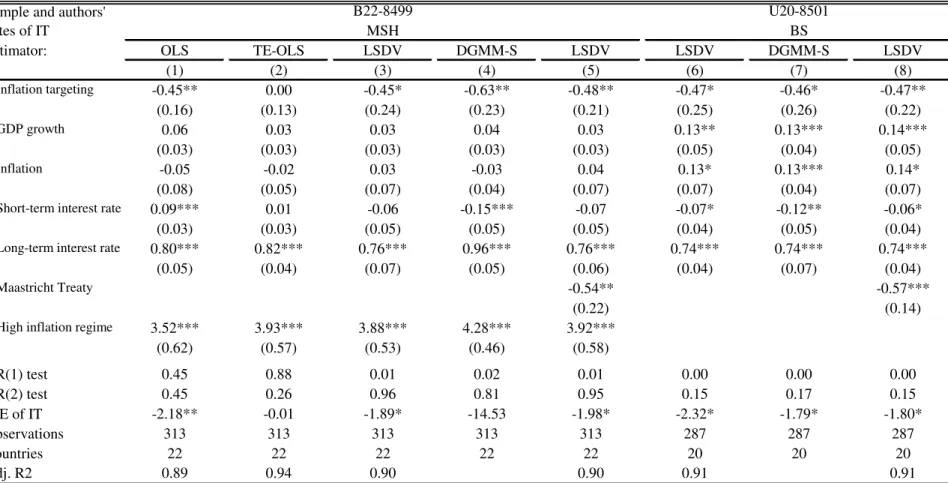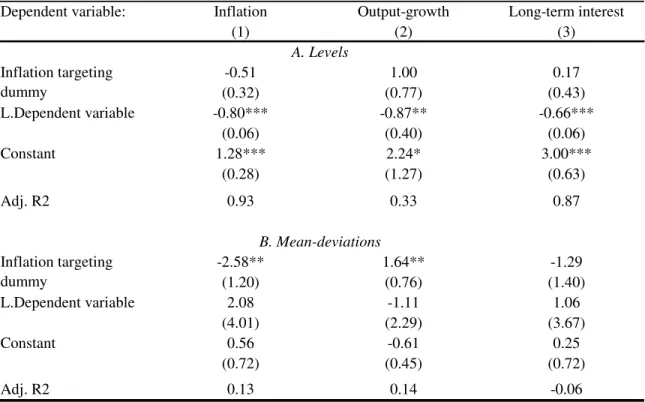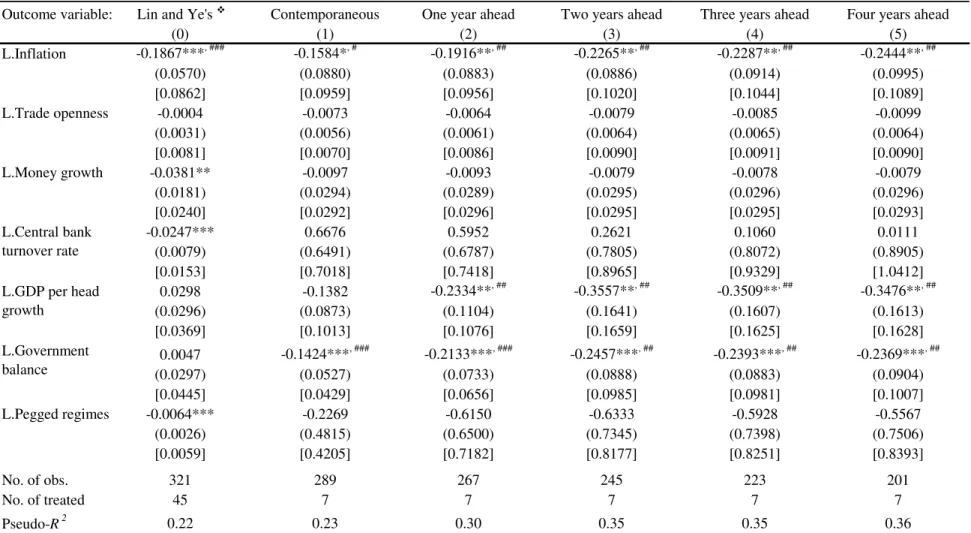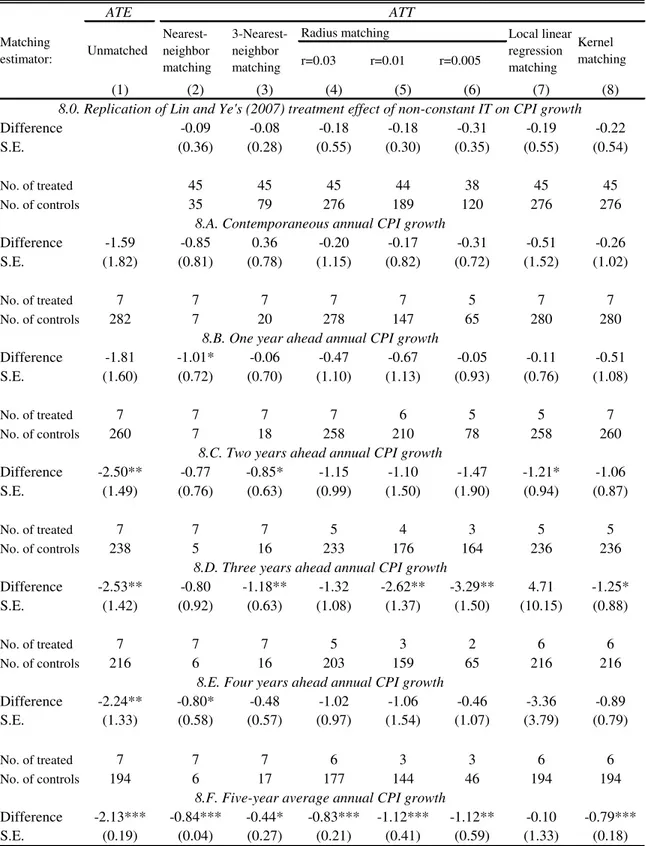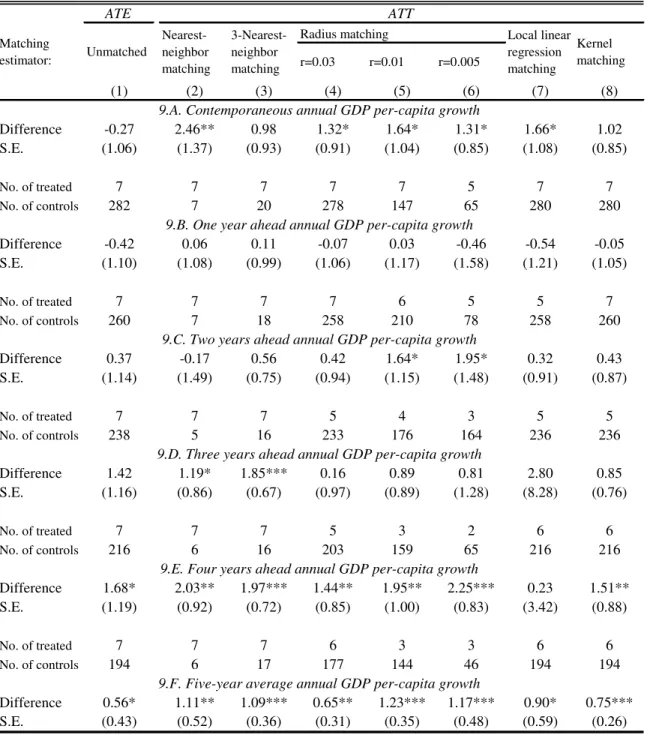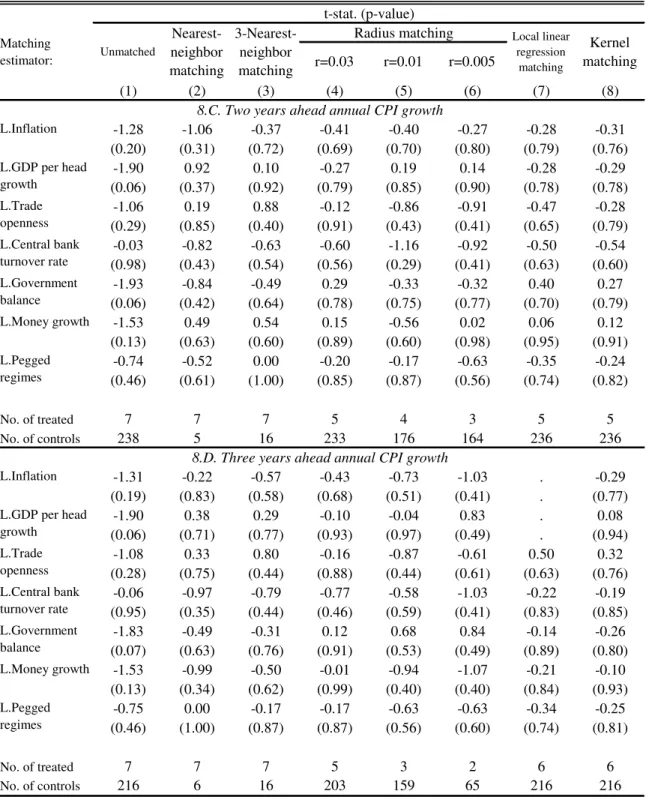Todos os direitos reservados.
É proibida a reprodução parcial ou integral do conteúdo
deste documento por qualquer meio de distribuição, digital ou
impresso, sem a expressa autorização do
REAP ou de seu autor.
Inflation Targeting did Make a Difference in
Industrial Countries’ I
nflation
and Output Growth
Ricardo Dias de Oliveira Brito
INFLATION TARGETING DID MAKE A DIFFERENCE
IN INDUSTRIAL COUNTRIES’ INFLATION
AND OUTPUT GROWTH
Ricardo Dias de Oliveira Brito
Ricardo Dias de Oliveira Brito Insper
Rua Quatá, nº300 Vila Olímpia
Inflation targeting did make a difference in industrial
countries
’ inflation and output growth
*Ricardo D. Brito
Insper Institute of Education and Research
Associate Professor, Department of Economics E-mail address: RicardoDOB@insper.edu.br
Phone: 55-11-4504-2431; Fax: 55-11-4504-8415.
Postal address: Rua Quatá, 300, São Paulo, SP 04546-042, Brazil.
March 2012
Abstract
I evaluate the treatment effect of inflation targeting (IT) among industrial economies in the early 1990s, controlling for common time and country specific effects, to show that IT had significant enhancing effects on realized inflation and GDP growth. By additionally showing that IT lowered the long-term nominal interest rates, I indicate that IT worked through the expectation channel, meaning that IT was received as an improvement in monetary policy. This credibility bonus of pioneering IT regimes was economically important, significant and robust to sample and technique variations, providing support for policymakers’ optimism at the inception of the regime.
JEL classification: E31, E52; E58.
Keywords: Inflation targeting; Inflation; Inflation-output growth short-run tradeoff; Dynamic panel; Difference-in-difference; Propensity score matching
* For valuable discussion and help in understanding the data, I thank Eurilton Araujo, Rinaldo Artes, Cyntia
Has inflation targeting (IT) made monetary policy more efficient in developed
economies? Have their pioneering IT systems, implemented in the early 1990s, resulted
in better realizations of inflation and output growth? Or, has IT subsequently spread
around the world just as a fad, without an initial track record of good performance?
Although the pioneering IT central banks seem happy with their choice, to the
point of having influenced the IMF recommendations and many other countries in a
subsequent wave of IT introductions after the mid 1990s, the existing evidence in terms
of realized inflation and output growth does not seem to support their optimism.1
Ball and Sheridan (2005) [denominated BS hereafter], for instance, put forth the
proposition that IT caused no significant improvement in realized rates of inflation and
output growth in a sample of major industrial economies. Although IT had a lowering
effect on inflation and a positive impact on GDP growth, they were not significant after
controlling these processes for mean-reversion in cross-section difference-in-difference
regressions. This view of IT irrelevance is shared by Lin and Ye (2007) [denominated LY
hereafter], who have found that IT had no significant effects on lowering inflation after
controlling for the self-selectivity bias of policy adoption in propensity score matches. 2, 3
In this paper, I demonstrate that IT did matter for realized inflation and output
growth. Through panel estimates of an adaptive Phillips curve that use data similar to LY
and BS, I show that the credibility bonus of IT policy amounted to a significant short-run
effect close to a 1 percentage point reduction in the annual mean inflation of inflation
1 King (2002) and Bank of Canada (2006) are two good examples of Central Bank(er)s optimism with IT.
IMF (2006) is a document that pleads IT adoption.
2See Walsh (2009) for a survey of the IT literature. He concludes that ‘… macroeconomic experiences
among both inflation targeting and non-targeting developed economies have been similar …’ (p. 195).
3 Studies like Geraats (1998), Roger and Stone (2005) and Crowe (2010) indicate that IT improved
targeting countries (ITers), or a cumulative effect close to a 2 percentage point reduction
(in Tables 2 and 3). Although small compared to the worldwide inflation reduction
observed during the 1980s, it is relatively large and significant in comparison with
average inflation among industrial economies close to 2% per year in the late 1990s.
In these same samples, the impacts of IT on the volatilities of inflation and output
were negative, but mostly insignificant (in Table 4). Even so, given that inflation and
output growth rates had to undergo unavoidable volatility to converge to the new
long-run goals during the period studied, the fact that IT did not cause increases in volatilities
also shows IT effectiveness in improving macroeconomic performance at its inception.
To rule out the suspicion that this result spuriously reflects the role played by
supply shocks across the pre- and post-IT periods, and is in reality the consequence of a
more credible policy, I first show that similar results still hold when I allow for time and
cross-section heterogeneity in the inflation sensitivity to output growth (in Table 3,
columns (6) and (10)). Second, and more intuitively, I show that IT adoption significantly
lowered the long-term nominal interest rates, widely recognized as a proxy for long-run
inflation expectations (in Table 5).
What has caused this qualitative change in BS’s and LY’s IT irrelevance results,
distancing their results from my finding of IT enhancing effects?
In face of the generalized and sizable inflation reduction of the 1980s and early
1990s, IT’s absolute importance was second-order. However, once in the low inflation
regime of the 1990s, IT did play a significant role, which is not captured by BS, LY and
Instead of working with cross-section difference-in-differences or panel
propensity score matches – respectively used by BS and LY – which make it difficult to
model the short-run monetary tradeoffs and to control for common time variation and
countries’ non-observable specificities, I suggest a dynamic panel approach that exploits
the time and country dimensions to isolate the improvement in performance exclusively
due to the IT regime from other sources that might overlap in a cross-section. In
evaluating non-simultaneous IT treatment, it is particularly important to control for the
1980-90s’ worldwide trend of falling inflation and macroeconomic volatility.4 By
investigating the within-country variation, the control for country fixed-effects and for an
appropriate set of observable covariates addresses some of the omitted variable bias and
improves the inference about the causal effect of IT on economic performance. I choose
to model data at annual frequency and to identify the IT effects with a one-year lag,
together with other observable controls. The annual frequency is a simple solution to
minimize the autocorrelation of the residuals, while parsimoniously keeping the
estimated equations in the AR(1) family. The one-year lag of the explanatory variables
gives some time for the sluggish responses to monetary shocks of macro variables, in
accordance with Batini and Nelson (2002), and also weakens some endogeneity
suspicions of the IT policy.
Besides analyzing LY’s 1984-1999 annual balanced panel of 22 industrial
economies, combined with (i) BS’s calendar of IT adoptions or (ii) Mishkin and
Schmidt-Hebbel’s (2007) [denominated MSH hereafter] calendar of IT adoptions, I study: (iii) an
annual balanced panel that extends LY’s data back to 1971, (iv) an annual unbalanced
4 See Cecchetti et al. (2006) for a cross-country study about the worldwide trend in the 1980-90s of falling
panel that covers BS’s sample of 20 industrial countries between 1985-2001, and (v)
another unbalanced panel with BS’s economies between 1980-2009. In all samples, I
have been able to show that the IT policy improved realized inflation and output growth.
Having overturned BS’s and LY’s conclusions of IT irrelevance, I then revisit
both studies. First, by subtracting the common time and country fixed effects from the
variables of interest, then running BS’s cross-section difference-in-difference regressions
with these mean-deviation transformed variables, I am able to show that IT significantly
lowered inflation, increased output and lowered long-term interest rates, in an example of
Ball’s (1994a) credible disinflation. Second, by reformulating LY’s propensity score
matching to fulfill the conditional independence assumptions (CIA) – of (i) one unit of
treatment per ITer and (ii) matching of observables before treatment, violated by LY –
once again, I reach the conclusion that the IT framework resulted in significant
improvements in the realizations of inflation and output growth among industrial
countries.
In sum, this paper reveals that the initial track record of IT was significantly
positive, in support of policymakers’ optimism, and thus justifying its spread around the
world after the mid-nineties.
The article is organized as follows. Section 1 compares the panel regression
methodology with the cross-section difference-in-difference regression and the PSM
techniques, showing that the linear dynamic panel procedure controlled for the right set
of covariates is a more suitable approach in contexts where short-run tradeoffs and
non-observables matter. Subsection 2.1 reports and discusses the main results. Ball and
2.3. The conclusions are in section 3, and the data sources and various samples used are
described in Appendix A.
1. Methodology
1.1. Linear Regression
I first work with a partial adjustment model:
y t n y n y t t n y IT
t n y t n y t
n y d X
y , ,1 ,1 ,1 , , (1)
where: yn,t is some macroeconomic performance indicator of interest; subscript n = 1,
2, …, N is for country; and t = 1, 2, …, T is for period in years. For concreteness, I will
sometimes refer to yn,t as “inflation” of country n in year t , but similar reasoning can
be applied to other indicators of macroeconomic performance, such as real output growth,
inflation volatility or output growth volatility. The lagged value yn,t1 on the right-hand
side captures persistence and mean-reverting dynamics. Among the independent
variables, my focus is on the IT dummy variable IT t n
d ,1 , equal to 1 if country n is an
inflation targeter in period t-1 and 0 if it is not. Hence IT t n
d , is the treatment variable.
The one year lag gives time for policy to transmit to the economy (for treatment to take
effect). The vector Xn,t1 accounts for other covariates. For example, when y refers to
inflation, Xn,t1 can include GDP growth, among others. The term
y t
effects that capture common shocks to all countries, y n
allows for cross-country fixed
effects, and y t n,
is the disturbance. The vector y
y y y
, , of common
coefficients has y
as the main parameter of interest for evaluation of IT policy
effectiveness.
BS’s model can result from the time degeneration of equation (1), which sums up
all the data available into t = pre-IT, post-IT periods, thus turning the (T-1)-period
dynamic panel (1) into a cross-section:
n e
X d
y
y nypost
y pre n y IT
post n y pre n y post
n, , , , , ,
where: yn,post is country’s n post-targeting average inflation value, yn,pre is its
pre-targeting value, and en,post
n n,post
. By subtracting yn,pre on both sides of theabove equation, BS estimate:
n e
X d
y y
yn,post n,prey' n,prey nIT,posty n,prey ny,post , (2)
with y'
y 1
.In equation (2), it makes sense that the treatment variable IT post n
d , is
contemporaneous with the dependent variable yn,post , given that IT
pre n
d , is always zero.
The necessary time lag for treatment to transmit to the economy is not a concern in the
mean or the standard deviation) over many post-treatment years. However, equation (2)’s
parameter estimates may be biased because of the omission of the time-effect variation
y t
and the impossibility of identifying the country-effect variation y n
from y post n
e , .
As Bertrand et al. (2004) point out, to ignore the time series information of the
datawould work well only if all targeters had adopted the regime at the same time. Then,
the periods covered by pre-IT and post-IT windows would be the same for every
country, incorporating exactly the same combination of time-effect variation, and
cancelling out in a between-country comparison. But since IT adoption happened at
different times for different economies, the pair of pre-IT and post-IT periods are not
the same for all ITers and have to be arbitrarily defined for non-ITers. This means that
the time-effect variation t cannot be ignored in the IT analysis.
Apart from the common time-variation problem, BS’s cross-section regression
would be useful to investigate the between-country variation, which is to ask whether
targeters have lower inflation. However, equation (2) also ignores unobserved
country-specific factors affecting both inflation dynamics and IT adoption, and may erroneously
suggest a causal relationship from IT to inflation. To investigate the “within-country”
variation, which is to ask whether a country is more likely to have a lower inflation in
case it adopts the IT framework, it is necessary to control for country-specific observed
and non-observed factors affecting both inflation and IT adoption. In addition to the
inclusion of appropriate covariates Xn,t1 in the regressions, this control can partially be
accomplished by the use of country-effects y n
, like in equation (1). Although y n
does
not control for the time variation of those country-specific non-observable factors, it
Regarding the estimation method of equation (1), the LSDV (least square dummy
variable) estimator may have a bias when T is small, as demonstrated by Nickell (1981).
With big N and small T, the Difference GMM of Arellano and Bond (1991) would be
advisable. However, Judson and Owen (1999) and Roodman (2008), among others,
indicate the weak instruments and over-fit risks of applying these techniques to panels
with small N relative to T. Judson and Owen (1998) additionally show that LSDV
performs well when N is small and T increases. Bruno (2005) develops a correction of the
LSDV estimator for panels, but that approach is only valid for strictly exogenous
regressors. Thus, in the absence of a best technique to handle this small N panel with
weakly exogenous regressors, I choose to present estimates from both the LSDV
estimator and Difference GMM.
The LSDV, or fixed-effect OLS estimator, is biased if the transformed
independent variables
,1 , 1
1 1
, *
1
, 1 ...
nt n nT t
n y T y y
y and
,1 , 1
11 , *
1
, 1 ...
n t n nT t
n Z T Z Z
Z , for ,1
, 1, n,t1
IT t n t
n d X
Z , are correlated with
the transformed error
y
T n y n y t n y t
n T ,2 ,
1 ,
*
, 1 ...
. The correlation between
* 1 ,t n
y and y,* t n
has been shown by Nickell (1981) to be negative, resulting in a
downward biased estimator of y
, known as the dynamic panel bias problem, which
shrinks as T gets larger.
The biases in the
y y
, LSDV estimators of (1) depend on the covariances
y
j t n t n
Z , 1, ,
cov for all t 2 and j = 1, …, (t - 2). Specifically for the inflation-IT
,
0 cov ,1 n,tj IT t n
d , meaning IT
t n
d ,1 is predetermined. After all, IT adoption is
generally motivated as a way of “improving” the inflation process behavior. Less clear at
this point is the sign of
nt j
ITt n
d ,1, ,
cov . While BS argue that countries with higher past
inflation tend to adopt IT, LY show (and I confirm in Table 7 below) that switches to the
IT regime are more probable when inflation is already low. This latter being the case, the
,
0 cov ,1 n,tj IT t n
d for t 2 and j = 2, …, (t - 2) would bias the LSDV
estimates of (1) upwards, thus making it more difficult to find that IT decreases inflation.
Even so, to confirm the sign and significance of the IT effects, I additionally present
Difference GMM estimates that treat the Zn,t1 explanatory variables as strictly
exogenous, and also as predetermined ones.
Because serially correlated residuals might cause the standard error for the
estimated y
to severely understate the standard deviation of population y , as
Bertrand et al. (2004) have shown, I cluster the standard errors by country and report
tests of whether the error term y t n,
is serially correlated. The assumption that the error
terms are not serially correlated is equivalent to their first-differences y t n,
being
first-order correlated but not second-first-order correlated.
1.2. Propensity score matching
In the above equations (1) or (2), the estimated y
is intended to represent the
average direct causal effect of IT on y over all years and all ITers. However, this is only
exact if all confounding variables have been properly included in the model and if the
control units. In other words, regression-based causality tests assume a simple CIA to
assure that treated and non-treaded subjects in the sample become comparable and there
is no selection bias.
Because a regression-based conditional independence test relies on a model of the
process determining inflation (or other macroeconomic variable), it implies auxiliary
assumptions that may be hard to assess and interpret. Hence, alternative tests able to relax
those assumptions are worth considering. Assuming that assignment to treatment only
depends on observable variables – and does not depend on non-observables – the
propensity score matching (PSM) approach is an alternative that is more focused on the
estimation of the propensity score of policy adoption,
n pre n pre
n pre n pre
IT post
n y X p y X
d
E , | , , , , , , , where p
yn,pre,Xn,pre
is the conditionalprobability of IT adoption, instead of on the model for outcomes,
n pre n pre
IT post n post
n d y X
y
E , | , , , , , . According to Angrist and Pischke (2009), this is attractive
in applications where the former is easier to model or motivate, while by leaving the
model for outcomes unspecified, PSM should increase robustness.
LY and Vega and Winkelried (2005) follow this approach, emphasizing they
address the self-selection problem of IT policy adoption ignored by BS and others. Not
explicit in their argument, though, is that it is the control for Xn,pre , and not the PSM
framework itself, which minimizes the selection bias. Although PSM provides a robust
measure of the conditional expectation function (CEF), given that regression also
approximates the CEF, differences between the PSM average treatment effect on the
treated (ATT) and the regression y
unlikely to be of major empirical importance. As Angrist and Pischke (2009) show, in a
cross-section context both can be motivated as a weighted matching estimator:
pre n pre n pre n pre n post n pre n pre n IT post n pre n pre n X y p X y p y X y p d X y g E , , , , , , , , , , , 1 , , , ,where g
yn,pre,Xn,pre
is a known weighting function. For the PSM ATT ,
1 , , , , , ,, IT
post n pre n pre n pre n pre n d p X y p X y
g , meaning that PSM weights are proportional to the
probability of treatment at each value for the covariates. For the y
regression,
pre n pre n d pre n pre n d pre n pre n pre n pre n pre n pre n pre n pre n pre n pre n X y E X y X y p X y p E X y p X y p X y g IT IT , , 2 , , 2 , , , , , , , , , , , , , 1 , , 1 , , , meaning
that regression weights are proportional to the variance of treatment at each value for the
covariates.5 Thus, it is BS’s and others’ lack of control for Xn,pre in the estimation of
equation (2) that may impair the results of the previous literature, rather than the linear
regression approach.
Further, as noted by Dehejia and Wahba (2002): “An important issue is whether
the assumption of selection on observable covariates is valid, or whether the selection
process depends on variables that are unobserved ... Only when the researcher is
comfortable with the former assumption do PSM methods come into play.” In the IT
literature, the propensity score of IT adoption is far from well understood and the
assumption that the political macroeconomic decision of IT adoption is not affected by
5 Note that for the average treatment effect (ATE),
,
1 , ,pre n pre n X
y
common-time and country-fixed non-observables seems too strong, given the cluster of
IT adoption in the beginning of the 1990s, and that the inflation process that IT seeks to
control is affected by common-time and country-fixed effects. The above points make
clear that PSM has drawbacks in the IT context, and is thus best advised as a
complementary exam rather than a superior technique.
Ignoring the plausible common time-variable and country fixed effects, to better
understand LY’s results, it is enlightening to describe how the PSM would work well in a
panel context. However, this is complicated by the fact that potential outcomes are
determined not just by current policy actions but also by past policy actions and
covariates. Given that ITer ni adopts the IT treatment from the year kni on, i.e. for
T t
kni ' , dIT,' 1 t' t
ni , to measure the average causal effect of IT on the outcome variable
n i
k h n
y , after h years of treatment, the researcher would have to compute:
0 | , 1
, 1
,
nihk nihk niIThk
h E y ni y ni d ni
ATT ,
where 1 ,h kn i
ni
y is the outcome in period
hkni
if country ni adopted IT and0 ,h kn i
ni
y
if not.
However, because the outcome that would have been observed if ITer ni had not
adopted IT policy 0 | , 1
,
IT k h ni k h
ni ni d ni
y is not observable, the researcher assumes that
potential outcomes are independent of treatment status, conditional on a scalar function
of covariates, i.e. the CIA
,
, 1 , 1
0 , 1
, n, n n| nkn, nkn
IT k h n k h n k h
n y d p y X
, , 1 , 1
0
, ni | ni 1, nikni, nikni
IT k h ni k h
ni d p y X
y
E by observable
, , 1 , 1 , 1 , 1
0
, ni | ni 0, nkni, n kni nikni, nikni
IT k h n k h
n d p y X p y X
y
E , and equivalently measures:
, , , , 0 | , , 1 | 1 , 1 , 1 , 1 , , 0 , 1 , 1 , , 1 , ni ni ni ni ni ni ni ni ni ni k ni k ni k n k n IT k h n k h n k ni k ni IT k h ni k h ni h X y p X y p d y E X y p d y E ATTor its sample analogue:
IT ni ni ni ni ni ni ni N ni k ni k ni k n k n IT k h n k h n k h ni ITh y E y d p y X p y X
N ATT 1 1 , 1 , 1 , 1 , , 0 , 1
, | 0, , ,
1
,
where NIT is the number of ITers.
If, additionally, one assumes, as LY does, that common-time varying effects do
not affect the outcomes, or the common-time varying effects have been extracted from
the outcome series, there is no need for the treatment and controls outcomes to occur at
the same time, and for any
Th
, the above equations can be rewritten as:
1 , 1 , 1 , 1 , , 0 , 1 , 1 , , 1 , , , , 0 | , , 1 | ni ni ni ni ni ni k ni k ni n n IT h n h n k ni k ni IT k h ni k h ni h X y p X y p d y E X y p d y E ATT , or
NIT ni ni ni
ni k ni k ni n n IT h n h n k h ni IT
h y E y d p y X p y X
N ATT 1 1 , 1 , 1 , 1 , , 0 , 1
, | 0, , ,
1
However, to measure the cumulative ATT over
H 1
years in a panel context,one has to average the ATThs :
H h h H ATT H ATT 0 11 (4)
1
1
| 0,
,
,
,1 0 1 1 , 1 , 1 , 1 , , 0 , 1 ,
H h N ni k ni k ni n n IT h n h n k h ni IT IT ni nini Ey d p y X p y X
y N
H
which, for the biggest H possible, approximates the cross-section ATT measure over all
post-treatment years, usually calculated in the PSM literature:6
pre ni pre ni pre n pre n IT post n post n pre ni pre ni IT post ni post ni post X y p X y p d y E X y p d y E ATT , , , , , 0 , , , , 1 , , , , 0 | , , 1| , (5)
that is the PSM analogue of the cross-section difference-in-difference y .
LY’s PSM results are flawed because, when attempting to compute (4), they
ignore that the year of IT adoption kni is a definite and fixed one for each country for
exogeneity to be preserved. Instead of conditioning on
, 1, , 1
ni ni nik
k
ni X
y
p for every
horizon h0 , LY condition on
ni ni nih k
k h
ni X
y
p , 1, , , and compute the measure:
6 Vega and Winkelried (2005) use equation (5) to evaluate the IT policy. However, although they analyze
industrial ITers’ performance separately, they do it against a control group that includes both industrial and emerging economies, thus not restricting the comparison group to units that are similar to the exposed ones,
,
,
, , 0 | 1 1 10 1 , 1 , , 1 ,
, 0 , 1 ,
ni IT
ni ni ni k T h N
ni nh nh nih k nih k
IT h n h n k h ni IT
ni p y X p y X
d y E y N k T LYATT
thus matching on observables that have already been influenced by previous h years of
treatment. Just taking into account the conditioning variables yn,h1 and yni,hkni1 , for
illustration, LY are matching the treated outcome after h years of treatment 1 ,h kni
ni
y
with non-treated 0 ,h
n
y ’s, not because they were similar before treatment started (h+1)
years ago, yni,k 1yn,1
ni , but because they were similar last year, after (h-1) years of
treatment, yni,hk 1yn,h1
ni . This violates the exogeneity assumption for h>0 , and
clearly results in underestimation of the treatment effect through time.
2. Results
Next, in subsection 2.1, I present the linear regression results. As explained in
section 1, a dynamic panel that controls for observable covariates is as able to address the
IT causal effect on inflation as the PSM, with the advantage of taking relevant
non-observables into account and making explicit the roles of past policy actions and
observable covariates in the inflation determination (or in another macroeconomic
variable). The samples used are described in Table 1 and detailed in Appendix A.
To make sure that the main results I obtained in subsection 2.1 are not technique
sensitive, in subsections 2.2 and 2.3 I show that similar qualitative results could have
been obtained by cross-section difference-in-difference and PSM, had BS and LY
< Insert Table 1 around here >
2.1. Main Results
In Tables 2 to 5, I show estimates of variations of equation (1), presented in
section 1. Table 2 presents estimates of the following adaptive Phillips curve with a set of
controls: . ) 6 ( 5 , 1 , 1 , 1 , 1 , 1 , 1 , 1 , 1 , , 1 , , t n n t t n ttg t n gdpg t n fix t n cggdp t n cbturn t n bmg t n open IT t n IT t n t n TTG GDPG FIX CGGDP CBTURN BMG OPEN d
Beyond the current and lagged inflations (n,t and n,t1), GDP growth
(GDPGn,t1), and terms of trade growth (TTGn,t1) – usual variables in an open economy
adaptive Phillips curve 7 – following Ghosh et al. (2002) and LY, I include other
potential determinants of inflation to certify that the IT effect shows up in a very
controlled model.
According to Romer (1993), greater trade openness (OPENn,t1) should imply
lower inflation, given the higher costs of a monetary expansion. Faster growth of the
money supply (BMGn,t1) should trivially be associated with higher inflation. Cukierman
(1992) argues that a higher turnover rate of the central bank governor (CBTURN5n,t1)
should be associated with higher inflation. By its importance in aggregate demand, higher
7 See Hutchison and Walsh (1998), Andersen and Walsher (1999), Mankiw (2001) or Mehra (2004) for
government surplus (CGGDPn,t1) should alleviate pressures to raise prices. Ghosh et al.
(2002) also introduce a dummy for pegged exchange rate regimes (FIXn,t1) and find that
these regimes presented lower average inflation worldwide.
<Insert Table 2 around here>
The first 4 columns of Table 2 show estimates for sample B22-8499 (described in
Table 1, column (1)) with Mishkin and Schmidt-Hebbel’s (2007) [denominated MSH
hereafter] calendar of IT adoptions (described in Table 1, column (5)). This is the sample
that gets more attention in this paper, not only because it was the sample used by LY,
with whose results mine differ, but also because it is a balanced panel that covers the
inception of the IT system. After 1999, 11 of these 22 industrial countries unified their
monetary policy under the European Central Bank, making it debatable whether they
should be analyzed as independent countries from then on. MSH’s IT adoption dates are
the closest to Bernanke’s et al. (1999) country-case studies and the IMF’s (2006). They
also better represent the common central bank operating procedure of starting an IT
regime with explicit targets for the coming year on rather than for the current year, as
described in Johnson (2002).
I present pooled cross-sectional OLS estimates in column (1), including the
common time-variable effect in column (2), and the common-time-variable and
country-fixed-effects in column (3). From the changes in coefficient estimates among these 3
columns, it can be seen that the common-time-variable and country-fixed effects do
affect inflation. The IT impact is already significant in the simplest model in column (1).
Although IT becomes less important with the inclusion of the common-time effect, it
showing that non-observables play a role in the inflation process. Both the direct impact
of IT on inflation, , and its cumulative effect,
1
, which accounts forsubsequent decreases over-time lagged inflation on the right-hand side, are significant.
Columns (3) to (8) of Table 2 present panel estimates with time and fixed-effects
for the various samples and two calendars of IT adoption described in Table 1. From
column (3) to (4), I change from MSH’s to BS’s IT calendar – the one used by LY – to
check how important it is to vary the dates of IT adoption. The different calendars of IT
adoption make a quantitative difference, but not important enough to change the
qualitative result that IT mattered. BS’s IT adoption dates reduce the IT direct impact on
the average inflation level from -1.37 to -1.01 percentage points, or its implied
cumulative effect from -2.28 to -1.68 percentage points. Anyway, the IT effect is still
significantly important, different from LY’s irrelevance conclusion (in their Table 3,
Panel A), and differences between columns (3) and (4) mainly reflect that my
identification strategy of a one-year lag in policy effects matches better with MSH’s
calendar.
In column (5), the balanced panel B22-7199 extends B22-8499 back to 1971 to
reduce the dynamic panel bias problem suspicion and to check if the IT effect is still
important when observed in a longer retrospect. The direct effect of IT is -0.77
percentage point, lower than the -1.37 percentage points from column (3), but is still
significant at 6% significance.
The estimates in columns (6) to (8) are based on U20-8501 and U20-8009
(described in Table 1, columns (3) and (4)). They are unbalanced panels of the 20
al. (2002) (as described in Appendix A). The results in column (7) are comparable to
BS’s IT irrelevance findings (in their Table 6.3), given that BS’s IT adoption dates are
used in it. From the comparison of columns (6) and (7), again, it becomes clear that the
combination of the one-year lag in policy effects with BS’s calendar captures less of the
IT effect than MSH’s calendar, but it is still significant.
Although smaller than column’s (6) estimates for data until 2001, in column (8),
the IT coefficient presents significant enhancing effects on inflation until 2009, meaning
that the average disinflation gain of the IT policy is still noticeable many years after its
introduction. Among many, one possible explanation for the reduction in size of the IT
effect is that non-explicit IT central banks incorporated best IT practices during the
2000s, as indicated by Geraats (1998), among others.
Regarding the goodness of fit statistics, in accordance with the assumptions, there
is no evidence of first-order autocorrelation of the residuals in the equations tested in
levels (OLS and TE-OLS, in columns (1) and (2)), or of second-order autocorrelation in
the equations tested in differences (LSDV, in columns (3)-(8)), respectively represented
by the p-values of the AR(1) and AR(2) test statistics. Besides weakening suspicion that
the significances found are the spurious result of autocorrelated residuals, these tests
show that the one-year period frequency suits the AR(1) model parameterization well.
If one agrees that the set of variables controlled for by LY is just the right set of
covariates, their inclusion in regression (6) is enough to interpret the IT-inflation
regression relation as a causal one as well. In the inflation-output tradeoff context of the
Phillips curve, this IT effect is what monetary economists call the “credibility bonus”, or
turnover rate is only significant in the 1985-2001 unbalanced panels, but even there it
does not obviate the IT effect.8 If CBTURN5n,t1 is a good proxy for central bank
independence, the results in Table 2 allow the conclusion that IT was effective in
lowering inflation, and its impact was in addition to central bank independence.
Further, with respect to columns (3) to (8) of Table 2, it can be seen that besides
lagged inflation, output growth and terms of trade growth, the usual characters in an
adaptive open economy Phillips curve, the IT dummy is the only variable that is
significant in all seven samples. The variables for exchange rate regime, trade openness
and broad money growth were rarely significant. The government balance surplus
(CGGDPn,t1) is significant for the samples that cover the period 1984-1999, but with a
positive sign that is opposite to that expected, and it becomes insignificant in column (6),
which just extends the same vintage of data back to 1971.
In Table 3, I exclude the variables that were not useful in explaining inflation in
Table 2, and return to a more parsimonious adaptive Phillips curve, where:
; 5 , 1 , 1 , 1 , 1 , , 1 , , t n n t t n ttg t n gdpg t n cbturn IT t n IT t n t n TTG GDPG CBTURN d (7)
8 The significance of CBTURN5 in sample U20-8501 might be the consequence of two facts. First, as
with the CBTURN5n,t1 kept in the equation to isolate the IT regime from other
observable differences of the central bank. 9
<Insert Table 3 around here>
The IT effects shown in Table 3 only change slightly from the pattern of Table 2,
generally becoming stronger and more significant. In columns (1) to (3), I again show
how non-observables affect the inflation process. Once again, different from LY’s
irrelevance conclusion, column (3) presents significant IT accomplishments, and the IT
effects are stronger in column (7), in contrast with BS’s irrelevance conclusion.
To analyze how serious the dynamic panel bias problem is, in columns (4) and (8)
I show Difference GMM estimates that treat the Zn,t1 covariates as strictly exogenous
(DGMM-S). Note that the autoregressive coefficients are not significantly different from
their LSDV pairs (respectively in columns (3) and (7)), and that the IT effect does not
change significantly either. Because it is reasonable to suspect that past inflation shocks
feed back into future realizations of the other explanatory variables, I also show
Difference GMM estimates with Zn,t1 predetermined explanatory variables (DGMM-P
in columns (5) and (9)). In spite of some loss of precision and unreasonably large
absolute sizes for the IT coefficients, caused by over-fitting (too many moments relative
to countries), the IT effect remains significant.
<Insert Table 4 around here>
9 I am aware that, in the intuitive case where successful IT adoption increases central bank independence
In Table 4, I estimate the IT achievements on the inflation and output growth
volatilities, as in equation (1), obtaining results that are comparable to those of BS’s and
LY’s tests. The inflation and output growth standard deviations went down because of IT,
although not as much as the inflation levels. Given that most countries were going
through unavoidable volatility to lower their long-run mean inflation, the fact that IT
adoption did not cause an increase in volatility is actually evidence of IT’s improvement
in macroeconomic performance.
To rule out the suspicion that the results presented so far spuriously reflect a
relatively more important role played by supply shocks across the pre- and post-IT
periods, and to confirm it is truly the consequence of a more credible policy, I first show
that similar results hold when I allow for time and cross-section heterogeneity in the
inflation sensitivity to output growth. In columns (6) and (10) of Table 3, I make the
output growth interact with (i) the standard IT dummy, nt
IT t
n L.Inflationtargeting
d , 1 , ;
(ii) a dummy variable equal to 1 for all countries in every period t after the average
year of IT adoption, Post1994n,t ; and (iii) a dummy variable equal to 1 for all years in
every country n that adopts IT, FutureITersn,t. The fact the IT intercept is still
negative and significant when the inflation responses to output are allowed to be different
between ITers and non-ITers (L.GDP growth*Future ITers), to vary across pre- and
post-IT periods in general (L.GDP growth*Post 1994) and to change after IT adoption for the
ITers (L.GDP growth*L.Inflation targeting), excludes spurious effects of decreases in the
variance of supply shock that may have occurred at different times in the different
Second, and more intuitively, I study the impact of IT on the nominal long-term
interest rate process, believed to be a proxy for long-run inflation expectations. Because
the nominal long-term rate reflects not only expectations of future inflation, but also
future activity levels, monetary policy tightness and the risk premiums related to those
factors, I model it as:
; , 1 , 1 , 1 , 1 , , 1 , , L t n L n L t t n L t n L gdpg t n L short IT t n IT L t n L t n GDPG short d long long (8)
where: long is the nominal long-term interest rate and short is the nominal short-term
interest rate.10 In Table 5, as in the inflation case, the IT lowering impact on the long rate
is already significant by simple OLS in column (1) and, although it becomes unimportant
with common-time effects in column (2), it confirms its significance when the
country-fixed effects are also included. IT had a significant direct impact on the average
long-term interest level of around -0.5 percentage point in columns (1), (3) and (6), or an
implied cumulative effect close to -2.00 percentage points, in spite of the simultaneous
decrease in risk premiums happening among future Euro members.11 The results are
similar for Difference GMM, although the autoregressive coefficient seems
overestimated in column (4). When I additionally control for the Maastricht Treaty effect,
the IT effect becomes even more significant in columns (5) and (8).
<Insert Table 5 around here>
10 I thank Niamh Sheridan for providing the nominal long-term interest rate data used in BS.
It is worth noting that the results presented so far are not incoherent with Brito
(2010), who, in a debate with Gonçalves and Carvalho (2010), shows that IT disinflations
were not less costly in the OECD. They discuss Ball’s (1994b) disinflations, i.e. events in
which the nine-quarter moving average of inflation went down by more than 2%, when it
is better to have a lower output-loss-to-inflation-reduction ratio, called output sacrifice
ratio. However, a lower output sacrifice ratio in Ball’s (1994b) context is not a necessary
or a sufficient condition for a policy to be considered more efficient in general, when not
only sizable disinflations but the whole business cycle has to be handled by monetary
policy. In other words, the fact that IT did not matter for “big” disinflations does not
imply that IT does not matter at all. And, indeed, the 2% cut-off used in these studies is
too coarse for the already low OECD inflation levels at the IT inception. Instead, given
the OECD economies adopted IT more as a regime to fine tune the whole business cycle
than a transient mean to disinflate, the current paper evaluates the average effect of the IT
treatment on inflation and output, conditional on their continuing tradeoffs and on other
covariates.
Nevertheless, the current paper’s findings are qualitatively different from those of
Brito and Bystedt (2010), who conclude that IT rendered no credibility bonus among
emerging economies. According to Brito and Bystedt (2010), the emerging ITers’ relative
inflation reduction was the compensation for their relatively lower output growth. Given
the early 1990s’ prevalent gap in credibility between industrial countries’ monetary
authorities and those of emerging economies, both papers’ results put together seem to
illustrate Ball’s (1995) imperfect credibility theory, where inflation control costs less for
(2005) and Mishkin’s (2000) suspicions that IT works better in already strong
institutional environments, and is thus not a panacea for emerging economies.
2.2. Ball and Sheridan (2005) Revisited
In Table 6, I revisit BS’s 20 country cross-section difference-in-difference
regressions. First, to show that their methods with my data also produce the irrelevance
result for IT, I present estimates by equation (2) for inflation, GDP growth and long-term
interest rates, respectively in columns (1) to (3) of panel 6.A, which are comparable to
columns (6) of BS’ Tables 6.3.B, 6.6.B and 6.8.B. In percentage points, the IT impacts
are close to -0.50 on inflation, 1.00 on output growth and 0.20 on the long-term interest
rate, all insignificant at 10% significance level, as in BS.12
<Insert Table 6 around here>
Second, in an attempt to control for common-time-variable and country-fixed
non-observables, I subtract these effects from the variables and re-estimate equation (2)
in panel 6.B. Even though the cross-section difference-in-difference set-up does not
permit accurate control of the processes’ short-run dynamics and tradeoffs with other
observable covariates, the IT effects become economically important. The IT
simultaneous enhancing effects to relative inflation and relative output growth confirm
the credibility bonus, suggesting additionally a context of relatively perfect credibility
close to Ball (1994a), where (relatively) credible disinflations can cause (relative)
economic booms.
12Although I used BS’ data for the nominal long-term interest rate, I do not get their result exactly (0.17
2.3. Lin and Ye (2007) Revisited
As explained in section 1 (and detailed in Appendix C for the referee’s benefit),
LY’s PSM application to a panel is not standard. Instead of one unit of treatment per ITer
(7 countries), they consider every year-country under IT as an independent unit to be
treated (totaling 45 events). Next, they match these units by their contemporaneous year
observable characteristics, instead of by their pre-treatment characteristics, and base their
evaluation on that same year inflation,
,
, 1 ,
, '1 ,'
0 , '
, 1 ' , '
, 1
'
, | 1, , | 0, n , n nit , nit
IT n n t
ni t ni IT
t ni t
ni d p X E d p X p X
E for all
ni
k
t' and , including
t'1 kni . By violating the CIA, LY’s results are subject tothe selection bias they propose to solve. The fact that current ITers have (or do not have)
current lower inflation rates, as measured by LY, is not conditional on ITers and matched
controls being similar before IT adoption. In other words, for the purpose of inferring the
IT treatment effectiveness, it does not imply that a country is more (or less) likely to
lower its inflation if it becomes an ITer.
<Insert Table 7 around here>
In Table 7, I reformulate LY’s Probit model of IT adoption (replicated in column
(0); or in Table C.1 for the referee’s benefit), fulfilling the requirements of: (i) one unit of
treatment per ITer and (ii) matching of observables before treatment, but keeping their
panel structure and the set of covariates. To calculate the probability of IT adoption,
instead of the probability of being an ITer calculated by LY, ITer observations are
included in the Probit estimation only if the country had not adopted IT previously, for
ni
k
– i.e., ITers observations are not used in the Probit estimation after the first year
for by LY are lagged by one year, p
n,1,Xn,1
instead of p
n,1, Xn,
. Finally,because I will match at horizon h , I need the outcome variable to exist at year
h
and have to avoid ITers’ outcomes already under treatment from becoming controls for
themselves. I thus drop the observations of all countries dated
T h
and theobservations of pre-treatment ITers’ years from which the term h ends up in their
treatment periods. These two latter precautions generate a different subsample and its
respective Probit for each horizon h .13
From sample B22-8499 combined with BS’s IT calendar (my equivalent of LY’s
sample), where the last IT adoptions happened in 1995, it is possible to compute the
h
ATT for h=0, 1, 2, 3, 4 . In Table 7, from columns (1) to (5), I present the IT adoption
Probit estimates,
, |n,1, n,1
n,1, n,1
IT
n X p X
d
E , for each of these five
subsamples.14 In the Probits, the explanatory variable last-year inflation has a negative
and significant impact on IT adoption, meaning that countries with lower inflation are
more likely to adopt IT. This is in accordance with LY, but runs counter to BS’
assumption that IT adopters had higher inflation, at least on the eve of IT adoption.
Among the seven observables studied by LY, inflation was the only one they lagged and
is the only one that has preserved its sign and significance. Compared to LY’s Table 2,
broad money growth, central bank turnover and pegged exchange rate regimes are now
13 For illustrative purposes, take as examples the sample B22-8499, the inflation difference two years after
IT adoption 2
1, 2| , 1,
, 1, , 1
0,2| , 0,
n,1, n,1
IT n n k
n k n IT
k n k
n d p X E d p X
E
ATT , and
Sweden’s IT adoption in year kni=1995 . Because n,2| p
n,1,Xn,1
does not exist in the samplefor =1998 and 1999, all countries observations for those years are dropped. Given Sweden’s just -before-treatment observables in (kni-1)=1994 are similar to Sweden’s observables in (-1)=1993 and 1992 , the
latter two Sweden’s years are good control matches for the former. However, (+2)=1996 and 1995 are already treatment years for Sweden, and should not be used as controls.
14 To check for the balancing of the covariates, in Appendix B, Table B, I present t-tests of differences
insignificant. Government balance surplus becomes negative and significant, with the
non-intuitive implication that IT adopters have looser fiscal policies.15 A greater
difference, and with an important implication, is that sensitivity to per capita GDP growth
changes to negative and significant in most of the subsamples, meaning that countries
with weaker output growth are also more probable to adopt IT in the sample. Although
PSM protocols would suggest the exclusion of observables that do not influence IT
adoption or inflation, since my objective in this subsection is just to review LY’s results,
I keep all of them to the end. 16
As stated before, another criticism to LY is that in trying to make sense of the
short-run effects of monetary policy, there is an inflation-output tradeoff to be chosen by
the central banker. For ITers already on their inflation targets, or below the targets – and
such cases happened according to Johnson (2002) – the IT confidence bonus can translate
into loose demand policies and higher short-term output growth. With this perspective of
monetary policy tradeoffs, I present estimates of the IT policy effects for inflation and
output growth in Tables 8 and 9. Panels A to E show the average treatment effect, ATEh
, in column (1), and the average treatment effect on treated, ATTh , for h=0, 1, 2, 3, 4 in
columns (2)-(8), calculated according to equation (3). Panel 0 in Table 8 replicates LY’s
approach (also reproduced in Appendix C, Table C.2 for the referee’s benefit) and panel
F presents the five-year average ATE5 and ATT5 values, calculated according to
equation (4).
<Insert Tables 8 and 9 around here>
15 The negative coefficient for L.CGGDP is basically driven by Finland and Sweden, which ran central
government deficits above 10% of the GDP in the year before their IT adoptions.
16 See also Vega and Winkelried (2005) and Mishkin and Schmidt-Hebbel (2002) for different propensity
From Tables 8 and 9, in panels A to E, columns (2) to (8), the fact that the point
estimates of inflation and output growth differences are almost always favorable to ITers
against non-ITers is convincing. Overall, the ITers performed somewhat better than the
non-ITers in most of the cases, and significantly better in some cases. The ATTs for
inflation are negative in 33 out of 35 matches in Table 8, and the ATTs for output
growth are positive in 30 out of 35 matches in Table 9. If one looks at the five-year
average ATT5 , calculated from equation (4) in panels F, to infer the effects of monetary
policy on the inflation-output tradeoff, all inflation-output growth pairs of differences
have a negative-positive sign, respectively meaning that lower inflation was achieved
with higher growth. As in subsection 2.2, this is an unexpected result from the
perspective of an inexorable short-run positive inflation-output growth tradeoff, and
closer to Ball’s (1994a) credible disinflation. Except for the “local linear regression”,
ITers presented an average inflation around 1 percentage point lower and/or an average
output growth one percentage point higher in the first five-years of IT treatment, with
one, if not both, of the outcome differences significant at the 99% confidence level.
3. Conclusion
In a comprehensive survey on the empirical evidence on IT, Walsh (2009, p. 195)
concludes that “… macroeconomic experiences among both inflation targeting and
non-targeting developed economies have been similar,” a puzzling contrast with
policymakers’ enthusiasm for the system. If it is possible that recent IT adoptions by
